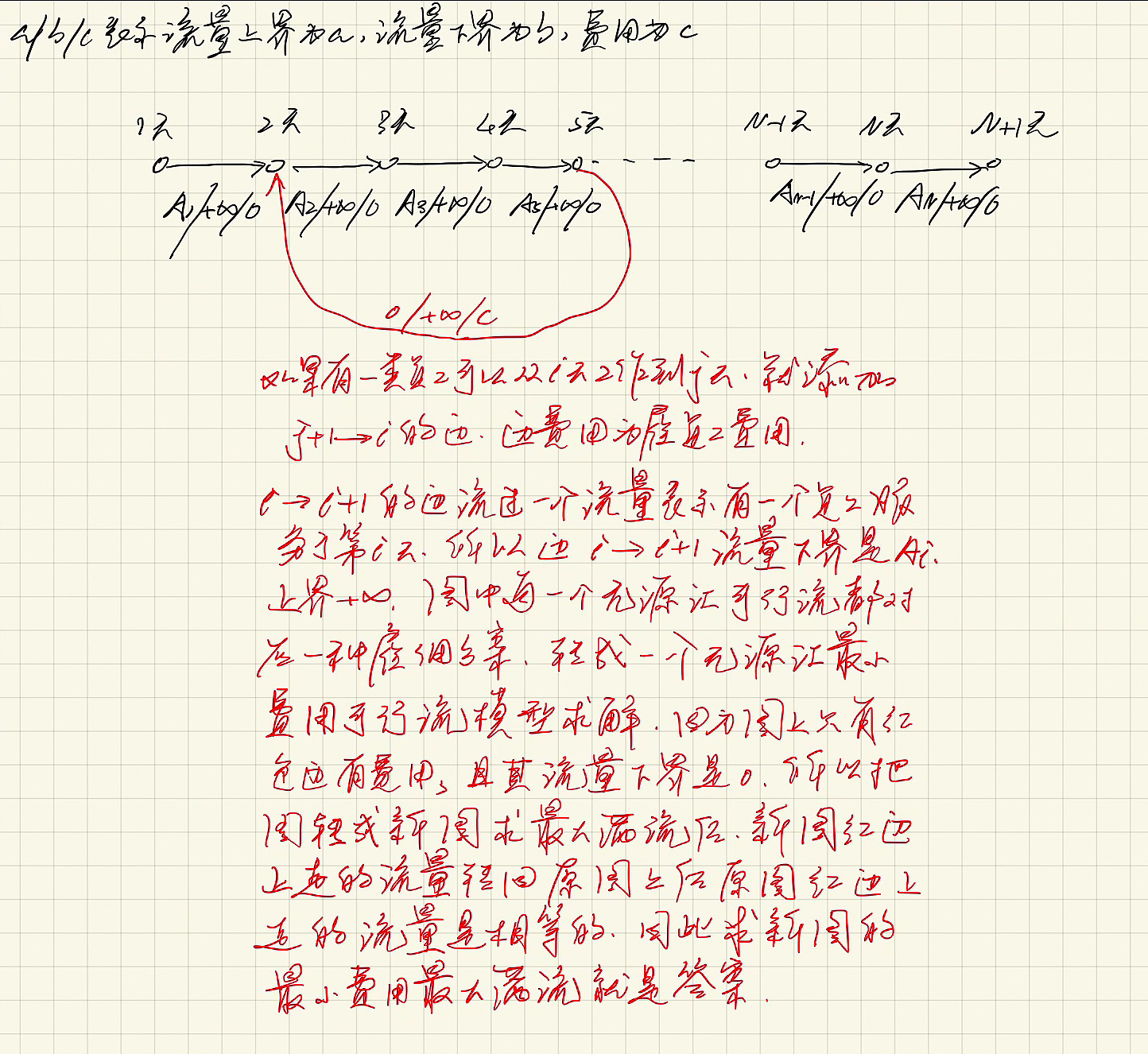
from collections import deque
class SPFA:
# 包含节点为1, 2, 3, 4, ..... max_node_num
def __init__(self, start_node, edges, max_node_num):
self.edges = edges[::]
self.start_node = start_node
self.max_node_num = max_node_num
self.link = {}
for a, b, w, idx in edges:
if a not in self.link:
self.link[a] = []
self.link[a].append((b, w, idx))
# 获取最短路径长度的列表[(节点1,长度1), (节点2, 长度2) .....]
def getMinPathLen(self, pre, f):
return self.getInfo(pre, f, min_path=True)
# 获取最长路径长度列表[(节点1,长度1), (节点2, 长度2) .....]
def getMaxPathLen(self, pre, f):
return self.getInfo(pre, f, min_path=False)
# min_path表示求的是最短路径还是最长路径
def getInfo(self, pre, f, min_path = True):
link = self.link
dis = [0x7fffffff] * (self.max_node_num+1) if min_path else [-0x7fffffff] * (self.max_node_num+1)
dis[self.start_node] = 0
updated_nodes = deque()
updated_nodes.append(self.start_node)
in_que = [0] * (self.max_node_num + 1)
in_que[self.start_node] = 1
for _ in range(self.max_node_num-1):
update_flag = False
# 利用上一轮迭代距离变小的点进行松弛操作
node_num = len(updated_nodes)
for _ in range(node_num):
a = updated_nodes.popleft()
in_que[a] = 0
if a not in link:
continue
for b, w, edge_idx in link[a]:
if f[edge_idx] == 0:
continue
if dis[a] == 0x7fffffff:
if w == -0x7fffffff:
new_dis = 0
else:
new_dis = 0x7fffffff
elif dis[a] == -0x7fffffff:
if w == 0x7fffffff:
new_dis = 0
else:
new_dis = -0x7fffffff
else:
new_dis = dis[a] + w
if (min_path == True and new_dis < dis[b]) or (min_path == False and new_dis > dis[b]):
dis[b] = new_dis
pre[b] = (a, edge_idx)
update_flag = True
if in_que[b] == 0:
in_que[b] = 1
updated_nodes.append(b)
if not update_flag:
break
return None
class FordFulkerson:
# 输入图中所有边列表[(from1, to1, weight1, cost1), (form2, to2, weight2, cost1), ......]
# weight是边的容量,cost是边的费用
# 边可以有重边和自环边
# souece_node 和 end_node 分别为源点和汇点
# 所有节点从1开始连续编号, max_node_num是最大节点数,max_edge_nums是最大边数
def __init__(self, edges, source_node, end_node, max_node_num, max_edge_num):
self.edges = edges[::]
self.source_node = source_node
self.end_node = end_node
self.max_edge_num = max_edge_num
self.max_node_num = max_node_num
# 费用流计算函数,min_cost为True时候获取最小费用最大流,反之获取最大费用最大流
# 返回(最大流数值,费用值,[(from1, to1, flow1, capacity1, cost1), (from2, to2, flow2, capacity2, cost2) ......])
# 流量方案以类表方式返回,五元组依次是边起点,边终点,边上走过的流量,原边容量,原边费用
def getCostFlow(self, min_cost = True):
e = [-1] * (self.max_edge_num * 2 + 1) # e[idx]表示编号为idx残量图边的终点, idx//2 就是残量图边对应的原图边的编号
f = [-1] * (self.max_edge_num * 2 + 1) # f[idx]表示编号为idx的残量图边的流量
c = [-1] * (self.max_edge_num * 2 + 1) # c[idx]表示编号为idx的残量图的边的费用值
ne = [-1] * (self.max_edge_num * 2 + 1) # ne[idx]表示根编号为idx的边同一个起点的下一条边的编号
h = [-1] * (self.max_node_num + 1) # h[a]表示节点a为起点的所有边的链表头对应的边的编号
orig_flow = [0] * (self.max_edge_num + 1) # 原图中有向边的流量
# 构建残量图
idx = 0
for a, b, w, cost in self.edges:
e[idx], f[idx], c[idx], ne[idx], h[a] = b, w, cost, h[a], idx
idx += 1
e[idx], f[idx], c[idx], ne[idx], h[b] = a, 0, -cost, h[b], idx
idx += 1
max_flow_val, cost_val = 0, 0
e1 = [(a, b, c, idx * 2) for idx, (a, b, _, c) in enumerate(self.edges)]
e2 = [(b, a, -c, idx * 2 + 1) for idx, (a, b, _, c) in enumerate(self.edges)]
e = e1 + e2
algo = SPFA(self.source_node, e, self.max_node_num)
while True:
pre = [(None, None)] * (self.max_node_num + 1)
if min_cost:
algo.getMinPathLen(pre, f)
else:
algo.getMaxPathLen(pre, f)
if pre[self.end_node][0] is None:
break
min_w = 0x7fffffff
path_len = 0
cur, edge_idx, next = self.end_node, 0, None
while cur is not None:
if next:
min_w = min(min_w, f[edge_idx])
path_len += c[edge_idx]
cur, edge_idx, next = pre[cur][0], pre[cur][1], cur
max_flow_val += min_w
cost_val += path_len * min_w # 累加费用
cur, edge_idx, next = self.end_node, 0, None
while cur is not None:
if next:
f[edge_idx], f[edge_idx ^ 1] = f[edge_idx] - min_w, f[edge_idx ^ 1] + min_w
# 更新原图边的流量
if idx & 1:
orig_flow[edge_idx >> 1] -= min_w
else:
orig_flow[edge_idx >> 1] += min_w
cur, edge_idx, next = pre[cur][0], pre[cur][1], cur
return max_flow_val, cost_val, [(self.edges[i][0], self.edges[i][1], orig_flow[i], self.edges[i][2], self.edges[i][3]) for i in range(len(self.edges))]
N, M = map(int, input().split())
lower_bound = [0] + list(map(int, input().split()))
e = [] # (每条边是(起点,终点,容量下界,容量上界, 费用))
for node in range(1, N+1):
e.append((node, node+1, lower_bound[node], 0x7fffffff, 0))
for i in range(M):
a, b, c = map(int, input().split())
e.append((b+1, a, 0, 0x7fffffff, c))
sub = [0] * (N+2)
for a, b, l, u, c in e:
sub[a] -= l
sub[b] += l
S, T = N+2, N+3
edges = [(a, b, u-l, c) for a, b, l, u, c in e]
for node in range(1, N+2):
if sub[node] > 0:
edges.append((S, node, sub[node], 0))
elif sub[node] < 0:
edges.append((node, T, -sub[node], 0))
print(FordFulkerson(edges, S, T, N+3, len(edges)).getCostFlow()[1])

